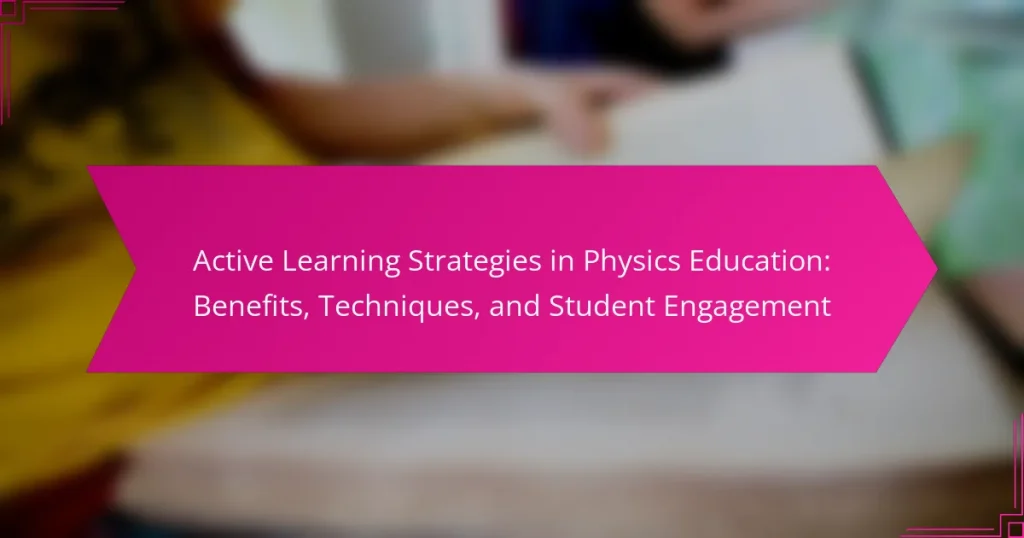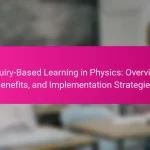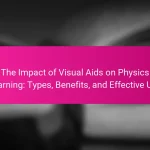Active learning strategies in physics education are instructional methods designed to actively engage students, fostering participation, collaboration, and critical thinking. Techniques such as peer instruction, problem-based learning, and interactive simulations have been shown to enhance student understanding and retention of physics concepts. Research, including a meta-analysis by Freeman et al. (2014), indicates that these strategies not only improve performance in STEM subjects but also boost student motivation and engagement. Various methods can measure student engagement in active learning environments, including observational techniques, surveys, and analytics from learning management systems. Overall, active learning strategies significantly enrich the educational experience in physics classrooms.
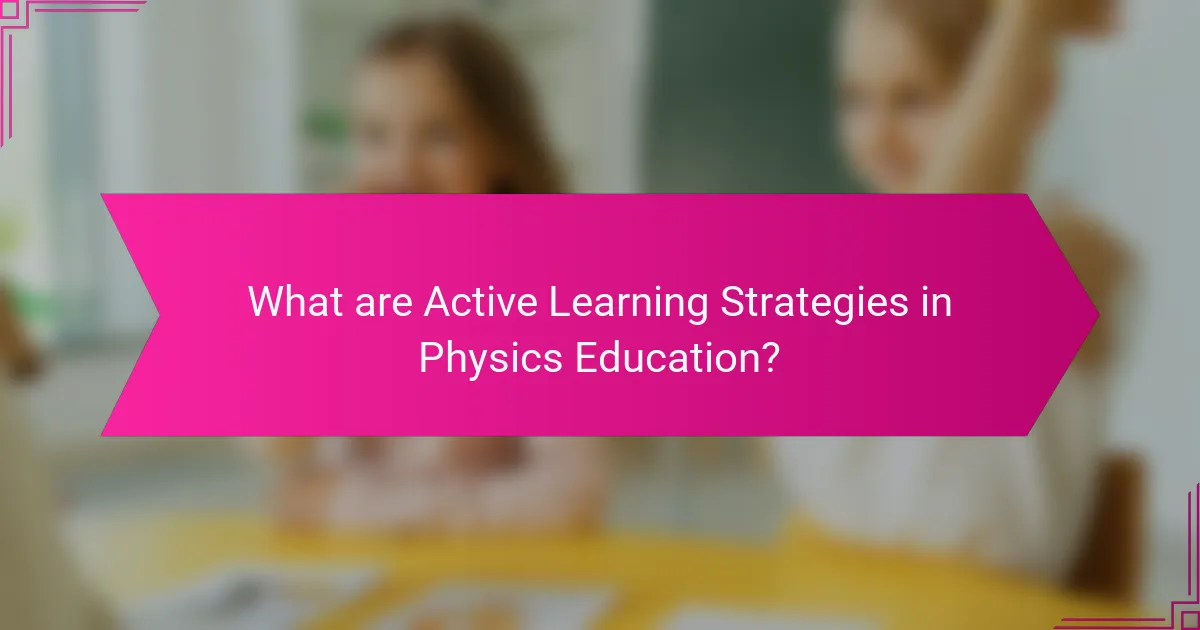
What are Active Learning Strategies in Physics Education?
Active learning strategies in physics education are instructional methods that actively engage students in the learning process. These strategies encourage participation, collaboration, and critical thinking. Examples include problem-based learning, peer instruction, and interactive simulations. Research shows that active learning can improve student understanding and retention of physics concepts. A meta-analysis by Freeman et al. (2014) found that active learning increases student performance in STEM subjects. Active learning also promotes higher student engagement and motivation. Overall, these strategies enhance the educational experience in physics classrooms.
How do Active Learning Strategies differ from traditional teaching methods?
Active learning strategies involve student engagement and participation, unlike traditional teaching methods that focus on passive learning. In active learning, students participate in discussions, problem-solving, and group work. Traditional methods often rely on lectures and rote memorization. Research shows that active learning can improve retention and understanding. A study by Freeman et al. (2014) found that active learning increases exam scores by an average of 6%. This highlights the effectiveness of active learning in enhancing educational outcomes.
What are the key principles of Active Learning in physics?
Active learning in physics is centered around engaging students in the learning process. Key principles include student participation, collaboration, and immediate feedback. Students actively construct knowledge through problem-solving and hands-on activities. Collaboration encourages peer-to-peer learning and enhances understanding. Immediate feedback helps students identify misconceptions quickly. Research shows that active learning improves retention and comprehension in physics. Studies indicate that classes utilizing active learning techniques can lead to higher exam scores. These principles foster a deeper understanding of physics concepts and enhance critical thinking skills.
Why is Active Learning important in the context of physics education?
Active learning is important in physics education because it enhances student engagement and understanding. This approach encourages students to actively participate in their learning process. Research shows that active learning can significantly improve retention of complex concepts. A study by Freeman et al. (2014) found that active learning increased exam scores by an average of 6% in STEM courses. Active learning techniques, such as problem-solving and group discussions, facilitate deeper comprehension. They also promote critical thinking skills essential for mastering physics. Overall, active learning creates a dynamic learning environment that fosters student success in physics.
What benefits do Active Learning Strategies provide in Physics Education?
Active learning strategies enhance student engagement and understanding in physics education. These strategies promote active participation, leading to deeper comprehension of complex concepts. Research indicates that students in active learning environments outperform their peers in traditional lectures. For instance, a study by Freeman et al. (2014) found that active learning increased exam scores by an average of 6%. Additionally, active learning fosters collaboration among students, improving communication skills. It also encourages critical thinking and problem-solving abilities, essential for mastering physics. Overall, active learning strategies create a more interactive and effective learning experience in physics education.
How do these strategies enhance student understanding of physics concepts?
Active learning strategies enhance student understanding of physics concepts by promoting engagement and critical thinking. These strategies encourage students to actively participate in their learning process. For example, techniques such as group discussions and hands-on experiments allow students to apply theoretical knowledge in practical situations. Research shows that active learning can lead to improved retention of information. A study by Freeman et al. (2014) found that students in active learning environments performed better on exams compared to those in traditional lectures. Additionally, these strategies foster collaboration among students, enabling them to learn from one another. Overall, active learning strategies create a more interactive and effective learning environment for physics concepts.
What impact do Active Learning Strategies have on student retention and performance?
Active learning strategies significantly enhance student retention and performance. These strategies engage students actively in the learning process. Research shows that active learning can lead to a 5% to 10% increase in retention rates. A study by Freeman et al. (2014) found that students in active learning environments performed better than those in traditional lectures. Specifically, students in active learning settings scored, on average, 6% higher on exams. Furthermore, active learning promotes critical thinking and problem-solving skills. This approach fosters a deeper understanding of the material. Overall, implementing active learning strategies is beneficial for improving student outcomes in education.
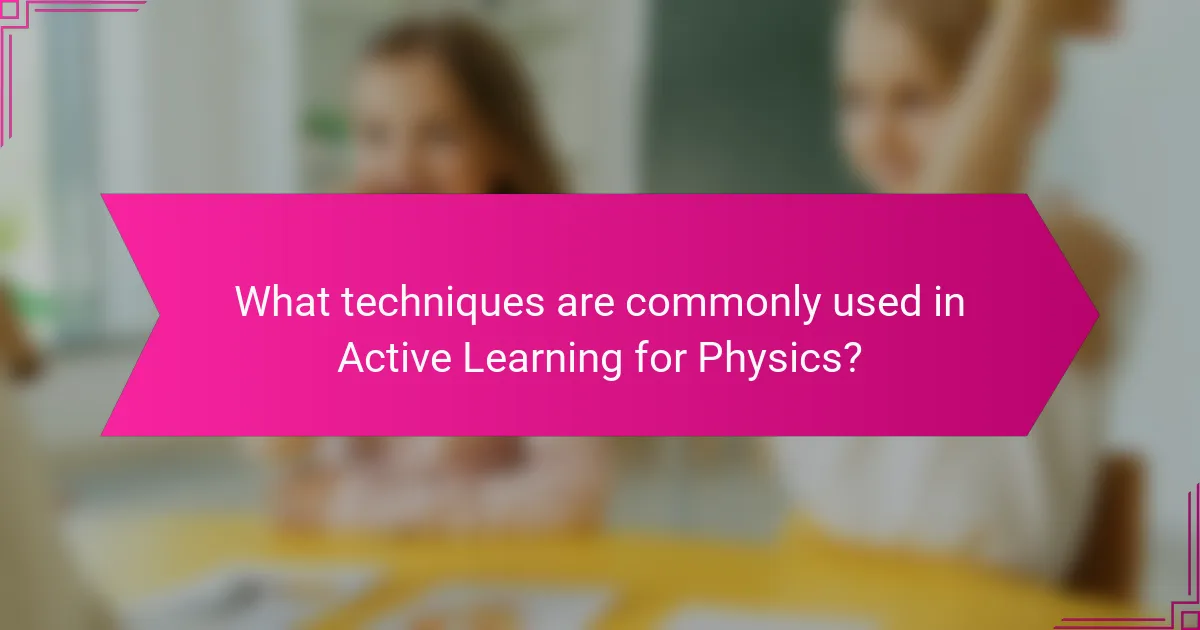
What techniques are commonly used in Active Learning for Physics?
Common techniques used in Active Learning for Physics include peer instruction, problem-based learning, and interactive simulations. Peer instruction involves students discussing and answering questions collaboratively. This technique promotes deeper understanding through dialogue. Problem-based learning engages students in solving real-world physics problems. It enhances critical thinking and application of concepts. Interactive simulations allow students to visualize and manipulate physical systems. These tools provide immediate feedback and foster experiential learning. Research indicates that these techniques improve student engagement and retention of knowledge in physics education.
How can collaborative learning be implemented in physics classes?
Collaborative learning can be implemented in physics classes through structured group activities. Teachers can assign students to small groups to solve physics problems together. This encourages peer-to-peer interaction and discussion. Group projects can also be used to explore physics concepts in depth. Utilizing technology, such as online collaboration tools, enhances engagement. Incorporating lab experiments where students work in teams fosters hands-on learning. Regularly rotating group members promotes diverse perspectives. Research shows that collaborative learning improves student understanding and retention of physics concepts. Studies indicate that students involved in collaborative learning perform better academically.
What types of group activities are effective for physics learning?
Collaborative problem-solving activities are effective for physics learning. These activities engage students in discussions and collective reasoning. They allow learners to tackle complex physics problems together. Research shows that students retain concepts better when they work in groups. Peer teaching is another effective group activity. It enables students to explain concepts to each other. This reinforces their understanding and builds communication skills. Hands-on experiments conducted in groups facilitate practical application of theories. Group simulations also enhance engagement and comprehension. Studies indicate that active participation leads to improved academic performance in physics.
How does peer teaching contribute to Active Learning in physics?
Peer teaching enhances Active Learning in physics by fostering collaborative learning environments. It encourages students to explain concepts to one another, reinforcing their understanding. This method facilitates deeper engagement with the material. Research shows that students who teach their peers retain information better. A study by Topping (2005) indicates that peer teaching improves academic performance and motivation. Additionally, it develops communication skills essential for scientific discourse. Overall, peer teaching is a powerful tool that promotes Active Learning in physics education.
What role does technology play in Active Learning Strategies for Physics?
Technology enhances Active Learning Strategies for Physics by providing interactive tools and resources. These tools include simulations, virtual labs, and multimedia presentations. They facilitate hands-on experiences that deepen understanding of complex concepts. For instance, simulations allow students to visualize physics phenomena in real time. Research shows that students using technology in learning environments perform better in conceptual understanding. A study by Harlow et al. (2019) published in the Journal of Physics Education Research found that technology integration significantly improves student engagement and motivation. Overall, technology plays a critical role in making physics education more effective and engaging.
Which tools and platforms are best suited for facilitating Active Learning?
Interactive platforms are best suited for facilitating Active Learning. Tools like Kahoot, Quizlet, and Google Classroom promote engagement through quizzes and collaborative activities. Learning Management Systems (LMS) such as Moodle and Canvas allow for structured course content and student interaction. Simulation software like PhET offers hands-on experiences in physics concepts. Video conferencing tools like Zoom enable real-time discussions and group work. These platforms support various active learning techniques, enhancing student participation and understanding. Research shows that using interactive tools increases retention and comprehension in educational settings.
How can simulations and interactive software enhance physics education?
Simulations and interactive software enhance physics education by providing immersive and engaging learning experiences. They allow students to visualize complex concepts and phenomena that are difficult to observe in real life. For instance, simulations can demonstrate the principles of motion, energy, and waves in a controlled environment. This interactive approach promotes active learning, encouraging students to experiment and explore various scenarios. Research shows that students using simulations achieve better understanding and retention of physics concepts. A study by the National Research Council found that students who engaged with simulations scored higher on assessments compared to those who learned through traditional methods. This evidence supports the effectiveness of simulations in improving physics education outcomes.
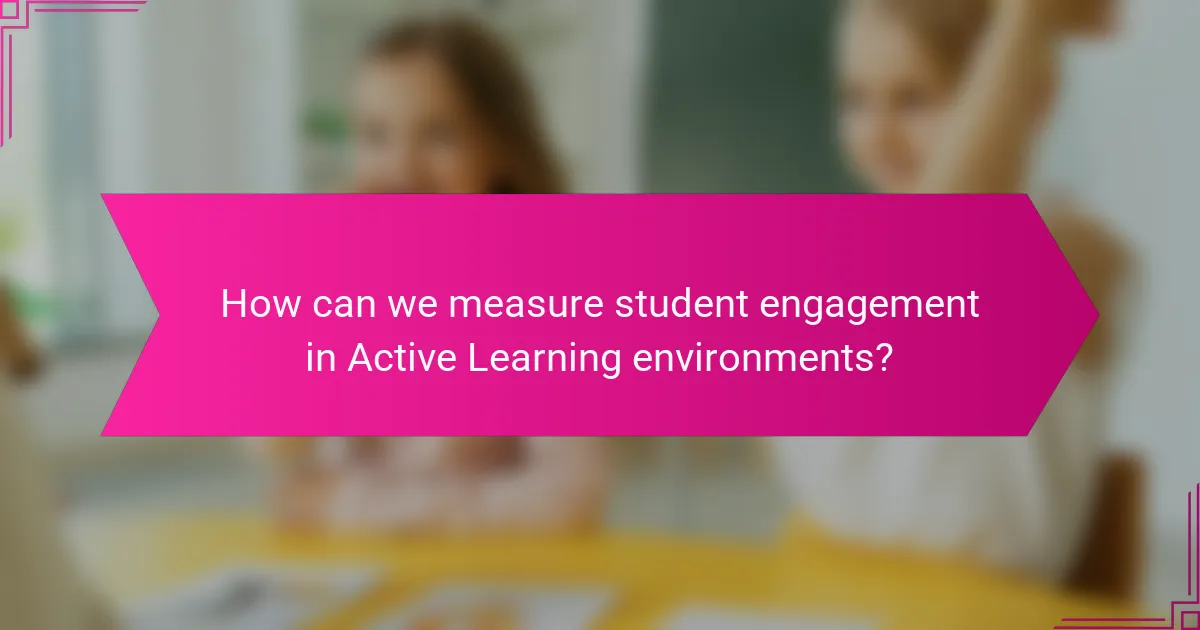
How can we measure student engagement in Active Learning environments?
Student engagement in Active Learning environments can be measured through various methods. Observational techniques can assess participation and interaction levels during activities. Surveys and questionnaires can gather student feedback on their engagement experiences. Analytics from learning management systems can track student activity and performance metrics. Peer assessments can provide insights into collaborative engagement. Additionally, reflective journals can capture personal engagement reflections from students. Research indicates that combining these methods yields a comprehensive understanding of student engagement levels. For instance, a study by Prince (2004) highlights the effectiveness of mixed-method approaches in measuring engagement in educational settings.
What indicators can be used to assess student engagement in physics classes?
Indicators to assess student engagement in physics classes include participation rates, attendance, and interaction frequency. Participation rates reflect how often students contribute to discussions or activities. Attendance indicates students’ commitment to being present in class. Interaction frequency measures how often students engage with peers and instructors.
Additionally, student feedback through surveys can provide insights into their engagement levels. Observational assessments can track student focus and involvement during lessons. Performance on collaborative projects also serves as a gauge for engagement. These indicators collectively offer a comprehensive view of student engagement in physics education.
How can feedback from students inform the effectiveness of Active Learning Strategies?
Feedback from students can significantly inform the effectiveness of Active Learning Strategies. It provides insights into student engagement and comprehension. For example, surveys and assessments can reveal which strategies enhance learning. This data allows instructors to adjust their methods accordingly. Research indicates that student feedback correlates with improved learning outcomes. A study by Hattie and Timperley (2007) shows that feedback is essential for effective learning. By analyzing student responses, educators can identify strengths and weaknesses in their teaching approaches. This iterative process enhances the overall quality of Active Learning Strategies.
What are some best practices for implementing Active Learning in Physics Education?
Best practices for implementing Active Learning in Physics Education include collaborative group work and problem-solving exercises. These techniques encourage student engagement and deeper understanding of concepts. Additionally, integrating technology, such as simulations and interactive tools, enhances learning experiences. Frequent formative assessments provide immediate feedback to students. Incorporating real-world applications makes the content relevant to students. Research shows that active learning can improve retention and comprehension in physics. A study by Freeman et al. (2014) found that students in active learning environments performed better than those in traditional lectures.
How can educators design effective Active Learning activities for their students?
Educators can design effective Active Learning activities by incorporating collaborative tasks and hands-on experiences. These activities should encourage student participation and critical thinking. For example, group discussions can enhance understanding of complex concepts. Simulations and experiments provide practical applications of theoretical knowledge. Research indicates that students retain information better through active engagement. According to a study published in the Journal of Educational Psychology, active learning can increase student performance by up to 20%. Therefore, integrating diverse methods fosters a more dynamic learning environment.
What common challenges might educators face when adopting Active Learning Strategies?
Educators often face several challenges when adopting Active Learning Strategies. One common challenge is resistance to change from both educators and students. Many educators are accustomed to traditional teaching methods and may hesitate to adopt new approaches. Students may also be uncomfortable with active learning, preferring passive listening.
Another challenge is the need for adequate training. Effective implementation of active learning requires educators to understand various techniques and their applications. Limited professional development opportunities can hinder this understanding.
Classroom management can also pose difficulties. Active learning often involves group work, which can lead to off-task behavior if not managed properly. Additionally, assessment methods may need to be adapted. Traditional assessments may not effectively measure learning outcomes in active learning environments.
Resource limitations can further complicate the adoption of these strategies. Some educators may lack access to necessary materials or technology to facilitate active learning. Lastly, time constraints can be a significant barrier. Educators may find it challenging to fit active learning activities into already packed curricula.
Active Learning Strategies in Physics Education are instructional methods designed to actively engage students, promoting participation, collaboration, and critical thinking. This article outlines the benefits of active learning, including improved student retention and performance, as evidenced by research showing an average increase of 6% in exam scores. Key techniques such as problem-based learning, peer instruction, and interactive simulations are discussed, along with the role of technology in enhancing these strategies. Additionally, the article addresses challenges educators may face when implementing active learning and provides best practices for effective design and execution in physics classrooms.
